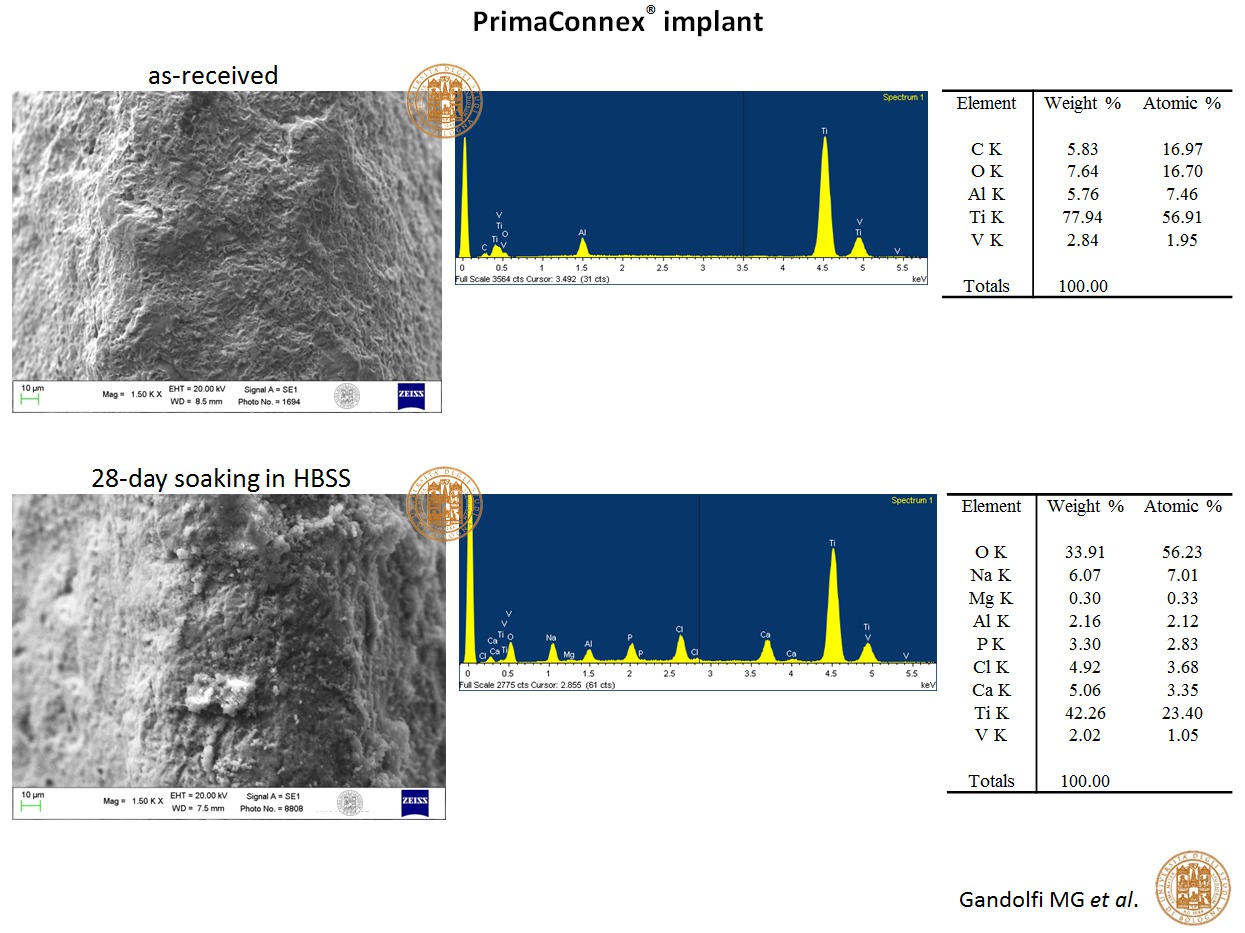IADR Abstract Archives
Microtopography, Microchemistry, Elemental Mapping and Reactivity in Simulated Body Fluid of PrimaConnex® Titanium Implants
Objectives: To study at the surface morphology and chemistry of titanium endosseous dental implants and its reactivity towards calcium phosphates (CaP) nucleation.
Methods: The surface of PrimaConnex® (Keystone Dental Inc., Burlington, MA, USA) internal connexion (patent 7,249,949) dental implants (ref. 15420K, lot.3482) was analyzed by ESEM-EDX to study the micro/nanotpopgraphy and the compositional characteristics (microchemical analyses and element mapping).
ESEM-EDX analyses were performed on as-received implants (t=0) and after 28-day soaking in a simulated body fluid (Hank's balanced salt solution, HBSS) to test the ability to form a layer rich in Ca and P (apatite or apatite precursors) following ISO 23317 specifications.
ESEM analyses were performed to evaluate: screws design and pitch, thread shape, texture, micro-topography).
Microchemical EDX analyses (weight % and atomic %) and element mapping were carried out to evaluate the relative element content, the Ca/P atomic ratio and element distribution.
Results: The data of surface morphology and microchemical analyses were slightly different among the subcollar, body and apex portions.
ESEM of as-received implants showed a uniform nano-texture with micro and nano-pits; the collar showed parallel streaks from machining process and the absence of pitting. EDX displayed (as weight %) Ti (78-90 wt%), C (1.8-5.8 wt%), O (0.0-7.5 wt%), Al (4.9-5.7 wt%) and V (2.9-3.6 wt%) (see figure).
After 28-day in HBSS, the surface was fairly different and showed milder roughness; peaks and irregularities seemed to be smoothed and softened. Sparse aggregates of globular particles having 1-2 micron diameter were detected. EDX displayed Ti, C, O, Al, V peaks reduced in intensity and also Ca, P, Na, Mg and Cl reflexes (see figure). Element mapping showed the amount and distribution of calcium and phosphorous on Ti surface and EDX data provided Ca/P atomic ratios consistent with (amorphous) metastable calcium phosphates precursors of apatite.
Conclusions: PrimaConnex® implants showed a macro-design feature of the screw and a nano-texture of the surface quite homogeneous among the different subcollar-body-apex portions but some difference in the microchemistry, and also demonstrated the ability to nucleate a film of calcium phosphates when immersed in a biological-like environment.
Methods: The surface of PrimaConnex® (Keystone Dental Inc., Burlington, MA, USA) internal connexion (patent 7,249,949) dental implants (ref. 15420K, lot.3482) was analyzed by ESEM-EDX to study the micro/nanotpopgraphy and the compositional characteristics (microchemical analyses and element mapping).
ESEM-EDX analyses were performed on as-received implants (t=0) and after 28-day soaking in a simulated body fluid (Hank's balanced salt solution, HBSS) to test the ability to form a layer rich in Ca and P (apatite or apatite precursors) following ISO 23317 specifications.
ESEM analyses were performed to evaluate: screws design and pitch, thread shape, texture, micro-topography).
Microchemical EDX analyses (weight % and atomic %) and element mapping were carried out to evaluate the relative element content, the Ca/P atomic ratio and element distribution.
Results: The data of surface morphology and microchemical analyses were slightly different among the subcollar, body and apex portions.
ESEM of as-received implants showed a uniform nano-texture with micro and nano-pits; the collar showed parallel streaks from machining process and the absence of pitting. EDX displayed (as weight %) Ti (78-90 wt%), C (1.8-5.8 wt%), O (0.0-7.5 wt%), Al (4.9-5.7 wt%) and V (2.9-3.6 wt%) (see figure).
After 28-day in HBSS, the surface was fairly different and showed milder roughness; peaks and irregularities seemed to be smoothed and softened. Sparse aggregates of globular particles having 1-2 micron diameter were detected. EDX displayed Ti, C, O, Al, V peaks reduced in intensity and also Ca, P, Na, Mg and Cl reflexes (see figure). Element mapping showed the amount and distribution of calcium and phosphorous on Ti surface and EDX data provided Ca/P atomic ratios consistent with (amorphous) metastable calcium phosphates precursors of apatite.
Conclusions: PrimaConnex® implants showed a macro-design feature of the screw and a nano-texture of the surface quite homogeneous among the different subcollar-body-apex portions but some difference in the microchemistry, and also demonstrated the ability to nucleate a film of calcium phosphates when immersed in a biological-like environment.

